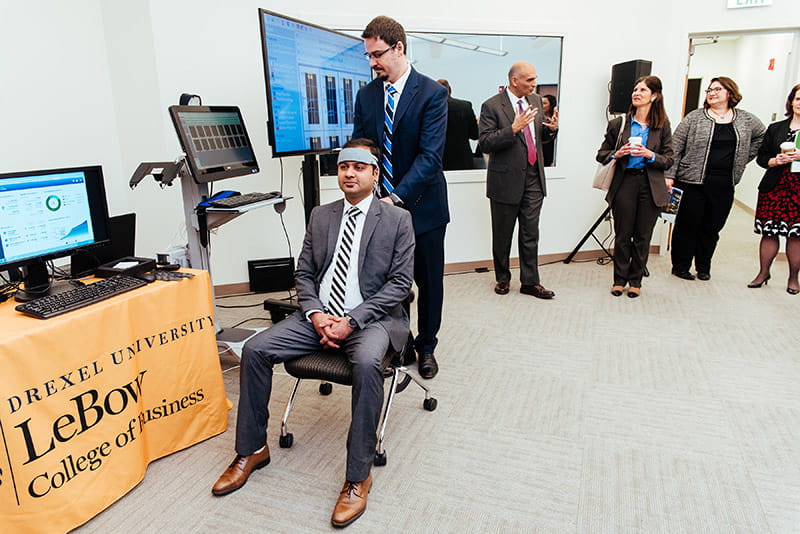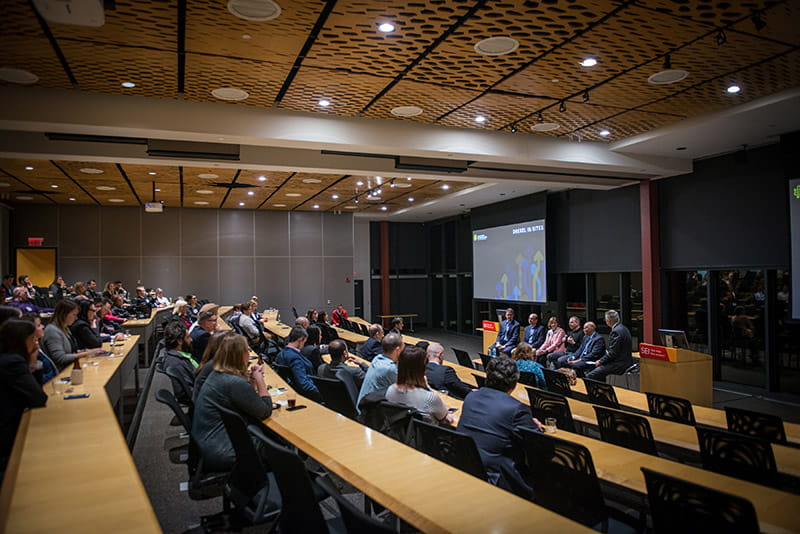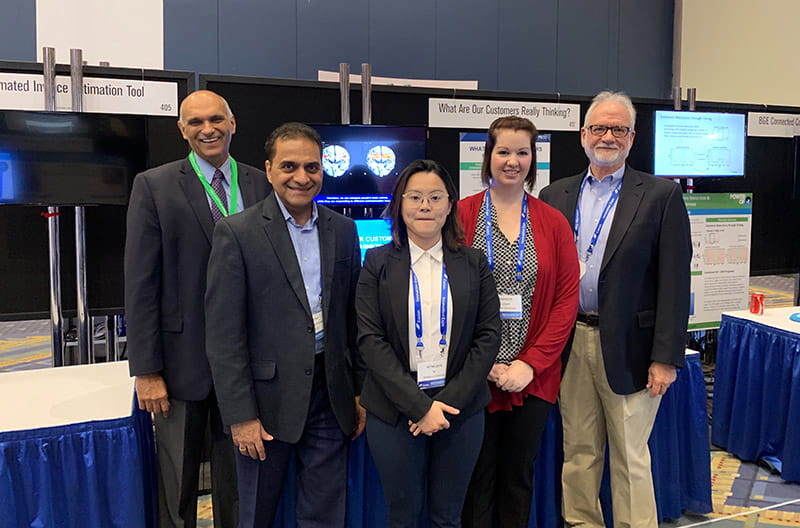Q&A: Interim Provost Paul Jensen, PhD, on Drexel Solutions Institute

Since 2018, Drexel University Solutions Institute (DSI) has functioned as the primary entry point for external partners seeking to collaborate with the University on custom training, research and evidence-based solutions. Launched just before Drexel’s centennial anniversary of co-op, which is being celebrated this academic year, DSI represents a reimagining of how the University engages with industry, building upon the 100-year tradition of co-op to meet the changing needs of students and strategic partners.
Originally spearheaded by the LeBow College of Business, DSI was elevated to a University-level initiative in December 2019, reporting directly to President John Fry.
“I think the Drexel Solutions Institute is one of the most important things I’ve been involved in during my 22 years here, in terms of the future successes of our students,” said Interim Nina Henderson Provost Paul Jensen, PhD, who, while previously acting as dean of the LeBow College of Business, helped develop and open the Institute.
In this Q&A, Jensen describes what makes the Institute's timing, how it’s benefiting students and faculty and why it’s setting up the University for future success.
Q: Why was the Drexel Solutions Institute formed?
A: For the last 100 years, we’ve had this very unique model of education that was founded on the idea of partnering with external organizations around co-op to create a talent pipeline, and that model has worked well for a long time. But Drexel’s partnerships with industry and nonprofits extend far beyond co-op into every aspect of what we do across colleges. The Solutions Institute was formed to raise the visibility of the comprehensive nature of these partnerships and to provide an easy way for industry to access Drexel talent and expertise.
Organizations are looking for more than a talent pipeline; they’re looking for talent development and R&D, for example; they realize they don’t have all of the skills or resources in-house for something like analytics or artificial intelligence, so they need training and research expertise. As a comprehensive research university with a unique educational model, we are perfectly positioned to help. And, in doing so, we prepare our students to be adaptable and ready for the challenges they’ll face post-graduation by immersing them in the issues and involving them in finding solutions now.
Q: How will this benefit Drexel?
A: The skills and exposure students need to be successful — not just when they graduate, but five or 10 years after that — is changing quickly. If we aren’t connected more directly to companies and organizations, we’re going to fall behind in terms of the relevance of our curriculum. The Institute is fundamentally about improving our programs through external partnerships for the benefit of students.
In the past, schools and colleges, in general, may have been able to get away with being disconnected from industry. At Drexel, we’ve had a connection through co-op and the Steinbright Career Development Center for a long time, and through faculty research in different units.

However, while Steinbright has always had these connections, the Institute is about tying the faculty and the colleges more directly to industry as well, so that we’re seeing what’s happening and what’s needed. That allows us to revise curriculum in real time to address what our students and organizations need. If we build more project-based learning into the curriculum — courses that bring students and faculty together to solve specific problems brought to us by our partners — then our courses remain relevant and updated automatically.
Q: Can you give some examples of what the students and faculty are working on?
A: Technological disruption is impacting the kinds of interdisciplinary projects we’re seeing currently. For example, the quantity of data that’s now being produced for companies to examine and study has resulted in projects around analytics and machine learning to better understand the needs and habits of customers. There have also been a number of projects in the area that I would broadly define as customer experience — using psychology, neuroscience and marketing to understand better the interactions between a company and the consumer.
These kinds of industry-driven interdisciplinary projects are critical to the success of Drexel as a comprehensive research institution. They tap into our broad research capabilities across schools and colleges and apply that work to business and societal problems in real time. The work being done by Drexel faculty and students is incredible; Drexel Solutions Institute is another mechanism for raising the visibility and impact of those efforts.
I firmly believe that in the next five to 10 years, higher ed will become more and more intertwined with industry. By launching the Drexel Solutions Institute, Drexel is poised to be a leader in that space, especially as DSI becomes more integrated across the University.
Q: With that goal in mind — integrating the Institute across the University — how do students and faculty get involved with DSI?
A: I think about the Drexel Solutions Institute as a portal or gateway into the University. DSI makes it easy for organizations to connect to different parts of Drexel. Some partners are looking for co-op students; DSI connects them to Steinbright. Some organizations are looking for executive education; DSI connects them to the appropriate expertise to provide training. Some want to study a specific problem brought on by tech disruption, and they lack the in-house expertise or resources to address it. In that case, the Institute will have discussions with the company to identify their specific needs and questions, and then identify the colleges and schools within Drexel that need to be involved to deliver a custom, research-driven, interdisciplinary approach to finding a solution. These approaches might take place in the classroom or in the lab, and could involve undergraduate and graduate students, PhD students and faculty from across the University.
Q: Are you able to give any examples of companies you’ve worked with?
A: For a short list — Vanguard, Pfizer, SEI, Johnson & Johnson, Campbell’s, Independence Blue Cross, PECO and Lavazza. There are a lot of companies we’ve done a fair amount of work with, because they’re local or Drexel already had partnerships with some of them. For the most part, it’s companies that we’ve historically had extensive co-op relationships with and now we’re recognizing the needs of these companies beyond co-op.
Q: Can you talk about some of the other ways this will benefit students?
A: From a student perspective, what students need now is a more interdisciplinary experience. More and more of the problems that students will be working on when they leave Drexel will involve computing, engineering, design, psychology, communications and so on. They will need to be creative, agile and engaged critical thinkers. That sort of preparedness and nimble, interdisciplinary thinking requires that we take an inclusive approach as a University, coming together across colleges and programs — and with strategic partners — to provide interdisciplinary experiences that reflect real life.

The Institute will help us leverage connections with organizations and better integrate across the colleges to create more interdisciplinary programs, courses and projects.
It’s important for students to have these experiences working in integrated teams on project-based work before they graduate from Drexel. When students leave Drexel, they’re going to be working in an integrated team that covers computing and engineering and design and communications and finance and marketing — students need to learn how to work in such environments now while they’re in school.
There’s another way to think about what the Institute is doing, and it relates to the silos at Drexel. I’ve already talked about how Drexel has been siloed by colleges and that needs to change. The other dimension is in terms of function. We’ve operated, for the most part, with research in one area, academic programs in another area and industry engagement in another. Though not completely, those three areas have been largely separate for the last 100 years. One of the important goals of the Institute is to integrate across those functions. The current model of having these three distinct areas of service, if you will, is not sustainable. It’s going to be more difficult to be successful as a University and provide relevance for our students if these things aren't integrated.
Q: To follow up with something you mentioned earlier: can you talk more about the executive education aspect of the Institute?
A: Education is becoming more modularized and more of a lifelong endeavor now, as opposed to the traditional model of going to school for four years and grad school for two years and that’s it. That is not going to work anymore because the pace of change is so rapid. Technology — like artificial intelligence and blockchain and the Internet of Things — is changing so rapidly that the skill sets one needs are changing just as quickly. As that happens, people in the workforce are going to need more upskilling and retraining. I think we’re going to see universities move away from providing only full degrees to more modularized skill-based certifications. By necessity, people who are starting college now are going to be lifelong learners, much more so than people of my generation.
This is why the Institute needs to build connectivity between the colleges and organizations. This partnership internally and externally allows us to be more agile and responsive, and to reinvent ourselves much more rapidly than any individual college could do on its own.
Q: How else is the Institute preparing Drexel for the future?
A: The country’s demographics are changing, so there are going to be fewer young people in the next couple of years. And technology is changing everything. Those two major market forces are going to impact universities. Many small colleges and universities won’t survive because there won’t be enough students and these institutions may not be able to deliver what’s really needed. The landscape is going to change dramatically. The thing that people need to recognize at Drexel is that we’re positioned ideally to address the changes that are already beginning.
Think of our defining characteristics: we’re a comprehensive research university; we’re a co-op university, which is important because we have relationships with companies that are deeper than most institutions; we’re in one of the largest metropolitan areas in the country; and we’re known as a technological university. Drexel is perfectly positioned to deal with technological disruption. The University can become a leader in reimagining what higher ed will look like over the next 20 years. The Drexel Solutions Institute and other initiatives around the University are going to be central to our success.
This story was published in the winter 2020 issue of Drexel Quarterly.Drexel News is produced by
University Marketing and Communications.

